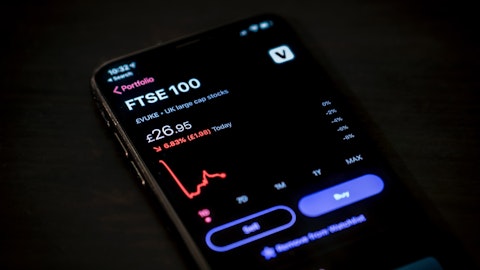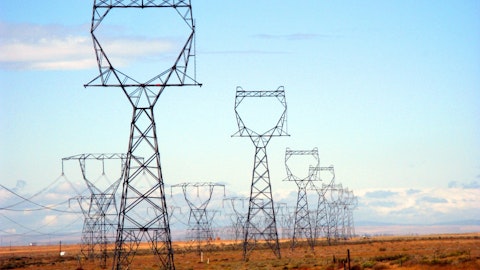American Electric Power Company, Inc. (NASDAQ:AEP) Q3 2023 Earnings Call Transcript November 2, 2023
American Electric Power Company, Inc. beats earnings expectations. Reported EPS is $1.77, expectations were $1.75.
Operator: Thank you for standing by. My name is Eric, and I will be your conference operator today. At this time, I would like to welcome everyone to the American Electric Power Third Quarter 2023 Earnings Call. [Operator Instructions]. I would now like to turn the call over to Darcy Reese, Vice President of Investor Relations. Please go ahead.
Darcy Reese: Thank you, Eric. Good morning, everyone, and welcome to the third quarter 2023 earnings call for American Electric Power. We appreciate you taking time today to join us. Our earnings release, presentation slides and related financial information are available on our website at AEP.com. Today, we will be making forward-looking statements during the call. There are many factors that may cause future results to differ materially from these statements. Please refer to our SEC filings for a discussion of these factors. Joining me this morning for opening remarks are Julia Sloat, our Chair, President and Chief Executive Officer; and Chuck Zebula, our Chief Financial Officer. We will take your questions following their remarks. I will now turn the call over to Julie.
Julia Sloat: Thanks, Darcy. Welcome to American Electric Power’s third quarter 2023 earnings call. It’s good to be with everyone this morning. Before I discuss our third quarter performance, I would like to introduce our CFO, Chuck Zebula, who will walk us through the results today. Chuck has been with the company for 25 years and has a deep understanding of our business. He hit the ground running in his new role, and we’re grateful for his leadership. Many of you are familiar with Chuck, and I’m confident that you enjoy working with him in the CFO role. I’m pleased to share that the execution of our strategy is on track. AEP is well positioned to deliver on a robust and flexible 5-year $40 billion capital plan with an emphasis on our generation fleet transformation and investments in our energy delivery infrastructure as we need our customer needs.
While our industry continues to transform amid this dynamic environment characterized by more extreme weather, rising interest rates and supply chain constraints, AEP has continued to adapt and take thoughtful actions to stay our course. We’re keeping the customer at the center of every decision we make, while also balancing and listening to our stakeholders who are critical to our success. This quarter, we made progress on our ongoing efforts to simplify and derisk our business profile through portfolio management, directing all proceeds of those efforts to the regulated business and to balance sheet management, which I’ll speak to in more detail in a moment. We’ve also been working hard on the regulatory front. I’ll provide insight into our success in the addition of renewable store portfolio and the many positive developments on regulatory and legislative initiatives.
A summary of our third quarter 2023 business updates can be found on Slide 6 of today’s presentation. AEP reported strong third quarter operating earnings of $1.77 per share or $924 million. We have a flexible business plan that allows us to deliver on our financial commitments while taking into account mild weather in the first half of the year and the higher for longer interest rate environment. As we actively manage the business today, we’re narrowing our guidance for 2023 full year operating earnings to a range of $5.24 to $5.34 while reaffirming the $5.29 midpoint and our long-term earnings growth rate of 6% to 7%. Moreover, last week, we announced an increase in our dividend, which is consistent with our earnings growth rate and within our targeted payout ratio of 60% to 70%.
In a few minutes, Chuck will talk about the support we have for our narrow 2023 earnings guidance range, which includes O&M management and positive load outlook as we drive economic development within our service territory. While our FFO to debt was 11.4% this quarter, we expect that this metric will improve materially by year-end and fall within the targeted rate of 14% to 15% in early 2024. Chuck will also touch on the short path to this balance sheet target. We continue to make progress in our efforts to simplify and derisk our portfolio. In August, we announced the completion of the sale of our 1,365 megawatt unregulated renewables portfolio to IRG acquisition Holdings, which resulted in after-tax proceeds totaling $1.2 billion. A summary of this sale can be seen on Slide 7.
We’ve also made headway on some of our other asset sales that we previously discussed. A summary of this can be referenced on Slide 8. In May, we announced the sale of our New Mexico renewable development solar portfolio, also known as NMRD. The book value of AP’s investment as of September 30 was $119 million. We’re currently on track with our 550 joint venture partner, PNM Resources, as we target to close on this transaction in the late fourth quarter of this year or early first quarter of next. We expect to continue the noncore business sales processes we have underway as we enter 2024. The sales of our retail and distributed resources businesses were launched in August with book value of $244 million and $353 million, respectively, as of the end of the third quarter.
We expect to reach a sale agreement in the first quarter of next year with an anticipated closing in the first half of 2024. In July, we announced the sales of Prairie Wind transmission and Pioneer Transmission, our noncore transmission joint ventures, as of the end of the third quarter, AEP’s portion of rate base associated with these investments was $107 million. We expect to launch the sales process soon and close in 2024. Finally related to , while there are no new updates for now. We anticipate completing the strategic review by the end of this year. So please stay tuned. AEP portion of rate base for this particular investment joint venture was $348 million as of quarter end. Let me shift gears and provide you with an update on our regulated renewables investment plan.
The teams remain focused and made solid progress. As you know, we have $8.6 billion of regulated renewables in our 5-year capital plan. We now have a total of $6 billion of the investment plan approved and an additional $800 million currently before commissions for approval with each of these projects providing valuable fuel savings for our customers. More detail on our renewable resource additions can be viewed in the appendix on Slides 32 through 34. As we’ve previously disclosed, both PSO’s 995.5-megawatt renewable portfolio for $2.5 billion and SWEPCO’s 999-megawatt renewable portfolio over $2.2 billion were approved earlier this year. At a collective $4.7 billion, these two portfolios alone comprise a large component of the approved $6 billion amount I just mentioned.
Additionally, in APCo service territory, we’re also pleased to report a positive development. In September, Virginia approved 143 megawatts of owned wind for more than $400 million, building upon APCo’s existing 29 megawatts of wind and solar projects that were approved last year, which totaled approximately $500 million. Moving across our service territory to I&M, we filed to seek approval for recovery of two investment — of investment in two owned solar projects totaling 469 megawatts, which represents $1 billion of total investment. We’re making progress on this front as we received commission approval last month in Indiana for both the 224-megawatt May Apple and 245-megawatt Lake Trout solar projects. In Michigan the Commission approved May Apple back in August, and we’ll decide on Lake Trout in the first quarter of next year.
We also await a commission order expected any time now for the 154-megawatt rock balls wind farm at PSO for approximately $150 million. Importantly, our regulated renewables plants are aligned with and supported by our integrated resource plans. We have issued a request for proposals for additional owned resources at APCo and IM with more to come from other operating companies in the near future as we listen and learn and respond to state preferences. Now I’d like to turn to updates on our ongoing regulatory and legislative initiatives. We’ve been engaged in efforts across our service territory to close the authorized versus earned ROE gap. Our third quarter ROE came in at 8.7%, driven in part by the unfavorable weather in the first half of 2023 that I mentioned earlier, which depressed this measure by 40 basis points.
While this is a modest improvement over the last quarter, we are aware that more can be done and more needs to be done on this front. Closing the gap will remain a primary focus into 2024 as we take federal state and customer preferences top of mind, along with meeting the needs of our communities. We remain focused on reducing the gap going into year-end, while still meeting our earnings guidance. To that end, I’m happy to confirm that we have settlement in place for APCo Virginia’s 2020 to 2022 triennial and APO Ohio’s ESP5, both cases which were filed earlier this year. we’re awaiting commission decisions in these states and Virginia’s orders expected in the fourth quarter of this year and Ohio will likely be issued in the first quarter of 2024.
In addition, we filed new base cases in Indiana and Michigan in the third quarter. Both filings we requested — in both on we requested a 10.5% ROE and taste drivers included distribution investment in technology, enhanced reliability and grid modernization using 2024 forecast and test years. We anticipate the new rates will be an effective next year. The team has been active on the legislative front in Texas — with Texas legislation pass and June allowing utilities to file the distribution cost recovery factor mechanism or DCRF twice per year, sit of once per year. This legislation also allows the DCRF mechanism to be used by utility, even if it has a pending rate case for seating underway. Consequently, the legislation will help improve AEP’s regulatory lag in Texas to the tune of approximately 50 basis points and earned ROE starting in 2024.
In fact, our April 2023 DCRF filing was approved and rates went into effect in September. For Kentucky Power, our June 2023 based base application incorporated the comprehensive rate review, a 9.9% ROE and a request to allow for the securitization of $471 million of regulatory assets, ensuring Kentucky Power is best positioned to provide safe and reliable service while managing costs. Constructive intervener testimony was filed in October, including support for securitization. By statute, implementation of interim rates is permissible in January 2024. Moving to PSO, you’ll recall that in May, we reached a settlement with the commission staff, the attorney general and other parties in Oklahoma’s PSO base case, which included a 9.5% ROE and provided for approval for more efficient cost recovery mechanisms.
We implemented interim rates in June while we await a commission order, which is expected any time now. As you know, the management of fuel cost recovery is a top priority with AP’s deferred fuel balance across our vertically integrated utilities shrinking sequentially and totaling $1.2 billion as of the end of the third quarter of this year. We have worked with stakeholders to intentionally adapt our fuel cost recovery mechanisms across our jurisdictions with the objective being to balance cost recovery with customer impact. So West Virginia fuel proceeding is approaching resolution. Recall in our April 2023 fuel recovery application, we filed two options for consideration. One option amortizes the fuel balance over 3 years. In the second option, we have respectively set forth for the West Virginia Commission consideration, the use of the 2023 securitization legislation to manage our $553 million deferred fuel balance along with securitizing store cost balances and net plant balances of generation assets.
The generation assets are currently embedded in rate and assume to operate through 2040 and securitizing those assets nearly fully offset the fuel cost recovery impacts to customers. We appreciate the engagement with all the stakeholder parties as we work toward a conclusion in this case by year-end and a constructive path for West Virginia. More detail on regulated activities can be found in the appendix on Slides 35 through 38. I’m pleased with the progress we’ve made this quarter and by the great work underway to actively manage the business, deliver on our commitments and create value for our investors, all while keeping affordability and reliability for our customers at the center of everything we do. We have a strong team in place, and I’m confident that we’ll continue to execute on our strategic priorities and advance our capital investment plan to deliver reliable, affordable power to our customers.

I look forward to seeing many of you in person at the EEI Conference in a couple of weeks. At the conference in Phoenix will provide some additional color on our business strategy, share our 2024 guidance and other financial details, including our 2024 through 2028 capital plan and related 5-year cash flows. Now with that, I’ll hand it off to Chuck, we’ll walk through performance drivers and details supporting our financial targets. Chuck?
Charles Zebula: Thank you, Julie. It’s good to be with you and everyone on the call this morning. As many of you know, I’ve been in many different roles at AP, but this is my first earnings call as the CFO. I’m truly honored to return to the exceptional finance team at AEP and lead this area as we embrace the opportunity to invest in our regulated utilities and serve our customers with affordable and reliable electric service. Today, I will discuss our third quarter and year-to-date results. share some updates on our service territory load and economy and finish with commentary on credit metrics and liquidity as well as confirming our guidance financial targets and a recap of our commitments to stakeholders. Let’s go to Slide 9, which shows the comparison of GAAP to operating earnings GAAP earnings for the third quarter were $1.83 per share compared to $1.33 per share in 2022.
Year-to-date GAAP earnings through September were $3.62 per share compared to $3.76 per share in 2022. As was mentioned on the second quarter earnings call, our year-to-date comparison of GAAP to operating earnings reflects the loss on the sale of the contracted renewables business as a nonoperating cost as well as an adjustment to true-up costs related to the terminated Kentucky transaction. In addition, we have reflected our typical mark-to-market adjustment and the impact of capitalized incentive compensation in Texas as nonoperating earnings as well. There’s a detailed reconciliation of GAAP to operating earnings on Pages 17 and 18 of the presentation today. Moving to Slide 10. Operating earnings for the third quarter totaled $1.77 per share or $924 million compared to $1.62 per share or $831 million last year.
The higher performance compared to last year was primarily driven by favorable rate changes and transmission project execution, increased retail load and favorable O&M across our segments. Operating earnings for vertically integrated utilities were $1 per share, up $0.03 from last year. Favorable drivers included rate changes across multiple jurisdictions, increases in retail load, depreciation, transmission revenue and O&M. These items were somewhat offset by higher interest expense and unfavorable weather year-over-year. the vertically integrated segment did see positive weather versus normal in the third quarter of about $0.04 per share, but this was compared to positive weather in the third quarter last year of about $0.06 per share. Consistent with our first and second quarter results, depreciation was favorable at the vertically integrated segment by $0.01 in quarter 3, primarily due to the expiration of the Rockport Unit 2 lease in December 2022.
However, if we exclude the impact of the lease depreciation would have been about $0.02 unfavorable, which is consistent with incremental investment activity in our vertically integrated segment. INM should see an additional $0.02 favorable net depreciation in the fourth quarter as well. The Transmission & Distribution Utility segment earned $0.39 per share, up $0.07 compared to last year. Favorable drivers in this segment included increased retail load, transmission revenue, positive rate changes in Texas and Ohio and favorable O&M Partially offsetting these favorable items were higher depreciation and higher interest expense. The AEP Transmission Holdco segment contributed $0.39 per share, up $0.06 compared to last year. Favorable investment growth of $0.02, coupled with favorable income taxes of $0.02 are largely driving the change here.
Generation and Marketing produced $0.18 per share, up $0.04 from last year. The positive variance is primarily due to favorable impacts associated with the contracted renewable sale in August, along with higher generation margins and land sales. These favorable items were partially offset by lower retail and wholesale power margins. Finally, Corporate and Other was down $0.05 per share, driven by unfavorable interest and partially offset by favorable O&M. Please note that our year-to-date operating earnings performance by segment is shown on Slide 16 in the appendix of our presentation today. Many of the positive drivers are the same for the year as for the quarter, and the negative year-to-date variance is driven largely by unfavorable weather and higher interest expenses.
Before we move on, I want to add a few more comments on O&M, including our outlook for the remainder of the year. We saw favorable O&M in the third quarter compared to the prior year, which was consistent with our expectations. For the fourth quarter, we are expecting more than $100 million of favorable O&M versus the prior year, which would bring us to a net favorable position for the full year from a consolidated perspective. The favorable change anticipated in the fourth quarter is largely a result of the timing of O&M spending in the prior year, including employee-related expenses and a contribution to the AEP Foundation in the fourth quarter of last year, along with continued actions we have taken, such as holding employment positions open, reducing travel and adjusting the timing of discretionary spending.
Turning to Slide 11. I will provide an update on whether normalized low performance for the quarter and our expectations through the end of the year. Overall, load has come in ahead of plan all year, and the third quarter was no exception. Looking to the bottom right-hand quadrant. Normalized retail load grew 2.1% in Q3 from a year earlier. You also noticed that we have updated our full year 2023 estimates based on the strong loan growth we’ve experienced year-to-date. Weather normalized retail load is now expected to finish this year 2.3% higher than 2022, an increase that is nearly 3x higher than our original expectations. This strength comes from exceptional growth in commercial load driven by data centers in Ohio, Texas and Indiana, but the third quarter also saw positive trends in our residential class, which is shown in the upper left-hand quadrant of the slide.
Residential load increased for the first time in more than a year in Q3 with growth of 0.6% from a year earlier. The relationship between customer incomes and inflation is a key driver of residential usage and has begun to stabilize as expected in the second half of this year. This month’s CPI data point was yet another encouraging sign that inflationary pressures on our residential customers are continuing to lessen. We note that residential usage per customer have seen slight declines this year as energy efficiencies increase, more workers return to offices and customers change behavior due to inflation. Fortunately, we are seeing strong enough growth in our customer base, especially in Texas and Ohio to help partially offset these trends.
Year-to-date, we have added nearly 30,000 residential customers across our footprint. Moving to the lower left-hand quadrant of the slide, our investor load declined in the third quarter, driven by a pullback in usage by some of our key manufacturing customers. namely chemical, plastic and tire producers as well as downstream participants of the energy industry. This reflects some of the softness in manufacturing nationally as producers have slowed activity in response to uncertainty around the economic outlook. We expect this to reverse itself in the months ahead as recent inflation and jobs data have reduced the probability of a recession occurring in the next year. We are forecasting industrial load to remain positive through the end of next year and beyond.
Moving to the upper right-hand quadrant of the slide, we see another impressive quarter for commercial load. In the third quarter, commercial load was 7.5% higher than a year ago, driven by the addition of new data center customers, mostly in Ohio, Texas and Indiana. We expect the pace of year-over-year growth in our commercial load to moderate some in 2024 as new projects work their way through the queue. Many of the large projects currently underway within our footprint won’t come fully online until 2025. However, there is upside if a few of these projects move forward earlier than expected. Many of these gains are directly attributable to our ongoing efforts to facilitate more economic development across our operating footprint. We know that working with local stakeholders to attract more economic activity is a key strategy to providing value to the communities we serve.
It allows us to prioritize investments that improve the customer experience while also mitigating rate impacts on our customer base. Moving to Slide 12. In the lower left corner, you can see our FFO to debt metric stands at 11.4%, which is an increase of 30 basis points from last quarter but continues to be well below our targeted range of 14% to 15%. The primary reason for the increase is a $1.8 billion decrease in debt during the quarter due to long and short-term debt retirements, driven by proceeds received from our contracted renewable sale and the successful completion of our planned equity units conversion, both of which occurred in August. We expect this metric will continue to improve throughout the remainder of this year and anticipate reaching our targeted range in early next year as we see an improvement in FFO during that time.
We have included a table on the slide that shows the path to the targeted FFO to debt range early next year. These items — these are items that impact both the 12-month rolling average as well as an estimated increase in the quarterly FFO. We anticipate a 180 to 190 basis point positive impact on FFO that enables the metric to be in the 13% to 14% range by year-end based on the following items: a roll-off of roughly $600 million in cash collateral, deferred fuel and other outflows from the fourth quarter of 2022 and continued cash recovery of deferred fuel balances in the fourth quarter of this year that total between $150 million and $200 million in accordance with the regulatory orders we have already received. Moving into 2024, the continued roll-off of prior year cash collateral outfall in the amount of $390 million in the first quarter of 2023 and a $90 million adjustment from unfavorable weather in the first quarter of this year to normal weather in our forecast for next year, will result in an incremental 100 basis point improvement put us within our target range of 14% to 15%.
Also, please note that we have updated our 2023 cash flow, as shown on Page 29 in the appendix. An increase of $1.2 billion in required capital is shown versus the original forecast, mostly due to a decrease of $800 million in cash from ops largely due to fuel inventory and an increase of $300 million in capital expenditures. Please note that our equity needs for 2023 are unchanged. The remaining years 2024 to 2027, along with rebilling 2028, will be updated at the upcoming EEI conference. Expect that this update will be consistent with our prior equity meetings and disclosures. Moving to Slide 13. You can see our liquidity summary in the middle of the slide. Our 5-year $4 billion bank revolver and our 2-year $1 billion revolving credit facility to support our liquidity position, which remains strong at $3.5 billion.
On a GAAP basis, our debt to cap decreased from the prior quarter by 220 basis points to 62.4%. This large change can be attributed to the large reduction in debt, driven by our contracted renewable sale and the completion of our planned equity units that I mentioned earlier. On the qualified pension front, our funding status decreased 1.9% during the quarter to 100.3%. This is largely due to equity and fixed income losses in the third quarter as interest rates increased and equity indices fell in both August and September. These losses are partially offset by a decreased liability due to rising interest rates. Let’s go to Slide 14 for a quick recap of today’s message. The third quarter produced growth in earnings well above the prior year, driven primarily by favorable rate changes, increased load and favorable O&M offsetting milder weather and increased interest expense.
As we continue to move through the fourth quarter, we are focused on cost management efforts with the goal of mitigating the headwinds we have faced this year, primarily unfavorable weather and higher interest costs. The strong third quarter results and low growth, coupled with our proactive plan for the balance of the year, allow us to confidently narrow our operating guidance range to $5.24 to $5.34 per share. We also continue to be committed to our long-term growth rate of 6% to 7%. And as Julie mentioned earlier, our sales efforts to simplify and derisk the AEP portfolio remain on track. We really appreciate your time and our management team and I look forward to seeing you at the upcoming EEI Financial Conference in Phoenix. With that, I’m going to ask the operator to open the call so we can hear your questions or comments.
Operator: [Operator Instructions]. Your first question comes from the line of Nick Campanella with Barclays.
See also 10 Best Social Media Platforms For eCommerce and 12 Stocks that Could Skyrocket According to Investment Newsletters.
Q&A Session
Follow American Electric Power Co Inc (NYSE:AEP)
Follow American Electric Power Co Inc (NYSE:AEP)
Nicholas Campanella: And congrats, Chuck on the new role. I wanted to actually start there, if I can. I know that there was just some language in the 8-K when you made the executive switch around the mandatory retirement age, in your interest in retiring before you reach that age. But I just wanted to ask, are your intentions here to stay on to the foreseeable future? Is this more temporary? Just how should we kind of think about your new role in company.
Charles Zebula: Yes. No, thank you for the question. And look, I am absolutely embracing this opportunity that we have before us. It’s very energizing to enter into a role like this. And although — the AK did indicate that I’m committed to Julie and AEP to write this out as long as needed. And as long as I’m adding value right to the opportunity. So thank you for the question.
Nicholas Campanella: I appreciate the answer. And then I appreciate the walk on the FFO. That’s helpful. I just wanted to confirm because S&P did move you to negative outlook. And I think in your prepared remarks, you said as you get to EEI, you anticipate equity needs being somewhat unchanged. So is it the right understanding that if you are in a CapEx rate scenario that your equity needs to still be modest and unchanged versus your prior view? And then secondly, understanding that the 11.4% has some reduction in debt from the renewable proceeds. The cash flow from those renewal proceeds, I guess, would be rolling off into next year. And I just want to triple check, that even with the asset sales, cash flow dilution, you still see yourselves above 14%.
Charles Zebula: Yes. Yes, thanks for both questions. So yes, our equity needs will be consistent, right, with what we have disclosed prior. I mean, clearly, we’ll be updating, right, the years in the cash flow forecast, but expect no surprises there. . On to your second question, yes, we tried to highlight right, on the slide, the FFO slide, the major drivers that you can point to and see what is rolling out as outflow. But absolutely, right, in our financial models, right? It takes into account, right, the absence of that cash flow. So we do expect to be in those ranges.
Operator: Your next question comes from the line of Jeremy Tonet with JPMorgan.
Jeremy Tonet: We’ve seen a bit of a regime change as it relates to interest rates out there, given the sharp moves recently. Just wondering if you could talk a bit more about that and how AP is able to affirm the 6% to 7% long-term CAGR there in what could be higher for longer interest rate environment? What impact do you see on EPS 2023? And kind of how do you think about offsetting those headwinds?
Charles Zebula: Yes. Joe, thank you for the question. I mean, look, we’ll be giving you a walk right on 2024 at EEI. But there’s no question that we are planning for an interest rate higher for longer environment. We’ve clearly been able to overcome those headwinds this year, but they will persist. So our plan is to, a, sensibly finance this company, right, continue to remain committed to mid-grade investment-grade credit. And our recovery mechanisms on interest rates, some of them are somewhat immediate or very near term, right? Some of them are kind of medium term and then some of them do have some lag associated with them. So the reality is some of this will begin to flow through. We remain committed to keeping parent debt in that range, well below 25%, 19% to 21% is ideal and offsetting those headwinds like with continued investment, we’re seeing strong loan growth and the positive regulatory outcomes and closing the ROE gap that Julie just mentioned.
Jeremy Tonet: Got it. That’s very helpful there. Maybe kind of picking up on that last point there. I think on the last call, we discussed a bit — or there’s some questions regarding outreach to commissions and just building regulatory relationships across the jurisdictions. I’m just wondering if you can provide a bit more detail, I guess, on specific initiatives done so far, where do you see that going? How you see that kind of transpiring so far?
Julia Sloat: Yes. Nick, thanks for the question. This is Julie. We continue on with that effort. In terms of engagement with our various state commissions as well as talking with folks at the FERC level. it’s important to note that we do this in conjunction with our operating company presidents and leadership there. And my objective and your senior leadership team’s objective is to clear the path operating company presidents and those teams so that they can have a very good traction with their respective commissions and their respective economies in the state. So those continue to occur. And honestly, just keeps me educated so that I can make sure that when we build the strategic plan at the aggregate level that it makes sense, and we’re taking into consideration our customers’ needs and also the economies that are driving all this magic that’s happening across our entire footprint.
So it continues as she goes in terms of those conversations, and we’ll continue to stay out in front of folks and do our best to support our operating companies. So nothing super exciting to report other than the action is absolutely happening, and we’ll see that embedded in the cases that we’re filing.
Jeremy Tonet: Got it. And just to confirm, the plan is still for you to meet each of the commissions when you’re able to do so?
Julia Sloat: Yes. Honestly, I enjoyed getting out anyway and talking with everybody. Like I said, I think it makes me better at my job. I’m making the round. And I got to be sensitive to what we’ve got going on in our respective jurisdictions. In some cases, I’ve got export issues I got to be sensitive to. But I’m absolutely making the rounds, and we’ll continue to do that because the business is incredibly dynamic more so than ever. And we need to make sure that we’re staying in touch with everything that’s going on across the entire organization. So that will continue on.
Jeremy Tonet: Got it. That’s very helpful. And just the last one, if I could. The waterfall chart through 9 months in the presentation today, it was a bit different than, I guess, what we saw on EEI. Just wondering if you could walk us through some of the puts and takes, the drivers to this, and across the different segments and what do you see, I guess, in the fourth quarter that maybe narrows the gap or just kind of the different trends happening such as in vertically integrated with renewables as well?
Julia Sloat: Yes. So I’ll start and I’ll hand it off the Chuck. So what gives us comfort in terms of narrowing the guidance range when you — I look at Page 16, I sum that’s where everybody is right now in terms of that waterfall chart. So what gives us a comfort is Chuck mentioned that we are able to effectively, I guess, take our low forecast predominantly driven by the commercial load that we’re seeing. So that’s going to be incorporated into our thoughts for the remainder of the year. We’re trying to manage the interest expense that’s also incredibly important. Another data point to throw out there. No question we keep getting is — what percentage of your debt outstanding is floating rate is about 12.5%, if I remember correctly, as of the end of the third quarter.
So that’s something that we’re being remindful of. We’re also thinking about what regulatory cases that we have already in hand. As a matter of fact, you may recall that when we began the year, we had something like $290 million of new rate release embedded in our forecast. Actually well north of that. We’re at about $303 million of secured rate relief in hand. So that gives us a little more confidence and comfort to as we proceed through the end of the year. So again, it’s really just steady as she goes and plug in Chuck. I don’t know, Chuck, had anything else you want to add to that?




